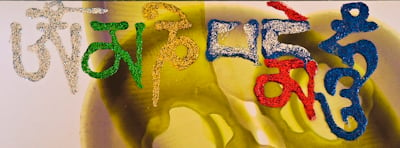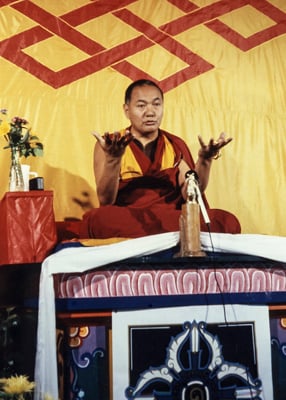Dear LYWA friends and supporters,
Thank you so much for your interest in and support of the Archive. Last month we sent you a request for help in fulfilling Lama Zopa Rinpoche’s wishes with respect to getting more of his teachings published. Many of you responded and we are very grateful for your support.
New Books
We are still sending out our latest title, Lama Zopa Rinpoche’s Bodhisattva Attitude, the first in our new Heart Advice Series. We have been receiving wonderful feedback about the book.
One reader says:
I find the arrangement of the material into teachings and practice really useful. I read the teachings for inspiration and the clear instructions on daily practice remind me to include the bodhisattva teachings each day into my morning sadhanas. This is a book that I will keep by my side.
And another reader told us:
I just wanted to drop a note of thanks for the Bodhisattva Attitude work you did. I took the book with me on a recent break and it was like cool water in the shade on my mind.
And our next book is in the capable hands of our wonderful designer, Gopa. It’s Rinpoche’s How to Practice Dharma: Teachings on the Eight Worldly Dharmas, the second in our Publishing the FPMT Lineage Series. You can read excerpts of this book here. It should be available in July, and if you are a Member you will have the choice of either downloading the ebook version from our Members Area or having a copy mailed to you. Please let us know your preference.
We’re also working on our second Heart Advice book which is a compilation of Rinpoche’s recent teachings on refuge, and our third FPMT Lineage book, The Perfect Human Rebirth. Stay tuned!
What's New On Our Website
Listen online to Rinpoche teaching at an animal liberation event with Venerable Master Hai-tao in Taiwan in March 2007. Two versions of this teaching have been posted: one version with the Chinese translation included, and one English-only version.
Read a commentary by Rinpoche on the how to meditate on the four immeasurable thoughts: immeasurable equanimity, immeasurable loving kindness, immeasurable compassion and immeasurable joy. Edited by Ven. Sarah Thresher.
 We have also just posted lightly edited excerpts from a one-month Mitukpa retreat held in Vermont in 2002. The excerpts include teachings on the meaning of retreat and how samsara is created.
We have also just posted lightly edited excerpts from a one-month Mitukpa retreat held in Vermont in 2002. The excerpts include teachings on the meaning of retreat and how samsara is created.
New Advice from Lama Zopa Rinpoche
We have just posted advice from Rinpoche on the benefits of chanting the Chenrezig mantra OM MANI PADME HUM in which he says:
If we recite ten malas every day, there is unbelievable purification. Eons and eons of negative karma are purified, especially if the practice is done with bodhicitta...
That means we come closer to enlightenment. Then, when walking on the road and the wind touches us, it is blessed. Then, when this wind touches others, they are purified and don’t have to experience the lower realms. By touching our body, others are purified. When we stand on a hill and those below look up, or if we are at the football stadium and others look at us, they are purified. We become meaningful to behold...The benefits are infinite. Then, when we die, Chenrezig stretches his hand out to us and helps us.
There is also a new advice on the benefits of doing nyung-näs, and a transference of consciousness meditation and a lovely description of Amitabha’s pure land in the section on Practices at the Time of Death. There are many other new advices as well; see here for a list of all the additions this month to the Online Advice Book.
New Paid and Volunteer Opportunities
We are looking to add a new member to our LYWA team: a Social Media Marketing Manager. We are looking for a student of Lama Zopa Rinpoche who will manage all of the Archive's social media initiatives (such as Facebook and Twitter) with the goal of increasing the Archive's visibility and generating inbound website traffic. This is a part-time, hourly position. You can find out more on our website.
We are also looking for a volunteer to help with our in-house Windows servers. If you have system administration skills and can offer a few hours for various projects, please contact our IT Manager, Jen Barlow.
Lama Yeshe Videos
As you know, we have been digitizing archival Lama Yeshe videos, enhancing their sound and picture quality and putting them out on DVD. Our next one, Lama Yeshe’s talk at Istituto Lama Tzong Khapa on Christmas Day 1982, is now ready to be made available but we’re still in the process of setting up our new YouTube channel, so when that’s done you’ll be able to see it. The new channel should be up and running by next month so look out for the June e-letter for confirmation of this.
And we’ve started work on our next Lama Yeshe series, his teachings on the Chenrezig Yoga Method, California 1980; this month's teaching is excerpted from this series.
Thank you again for your kind interest and support.
Much love, 
Nick Ribush
Director
This Month's Teaching: Ground Zero: Emptiness as the Basis for Deity Yoga
 The main body of any yoga method begins with meditation on emptiness, or, in Sanskrit, shunyata. This is sometimes called the shunyata deity, but that’s just a philosophical term. Anyway, we’re all meditating on emptiness already. We started a long time ago. Ages ago.
The main body of any yoga method begins with meditation on emptiness, or, in Sanskrit, shunyata. This is sometimes called the shunyata deity, but that’s just a philosophical term. Anyway, we’re all meditating on emptiness already. We started a long time ago. Ages ago.
We begin our meditation on emptiness by contemplating on the clean clear nature of our own thought, or mind. This approach is important.
First, it’s crucial that we employ introspective wisdom to investigate what the mind is. Mind is the nuclear energy that produces all the different kinds of life. Basic Buddhist philosophy teaches that in the evolution of sentient beings’ existence, the root of life is the mind. Mind is the creator of body and life.
The meditation object
When we talk about meditation, what is it that we meditate on? There has to be an object involved; there is an object of meditation. We have to be clean clear about that also. We have to start our meditation by recognizing one particular object, otherwise our meditation will get lost. We have to start somewhere and anybody who instructs others in meditation has to point out to them exactly what the meditation object is.
If we try to meditate without having a clear idea of the object we’ll just space out and get nowhere. That’s not what Buddhism understands meditation to be. We’ve been spaced out long enough. So this time, instead of letting our mind wander about lost in a cloud of distracted thought and reacting to whatever arises, we need to bring it to a stop and focus on an object.
This is how we should meditate on the lamrim as well. lamrim meditation is not a joke. It’s a serious undertaking where we pick one aspect of reality and investigate it thoroughly through analytical meditation. We really focus our mind on the particular topic we have chosen and don’t allow it to wander this way or that. Doing that properly also takes much time.
So anyway, whether we’re doing analytical meditation or practicing single-pointed concentration, we need to focus our mind on one object. This is how we start to control our mad elephant mind, and that’s the purpose of meditation—to direct the mad elephant mind in the right direction. So when we meditate we should not lose the point of why we’re doing it.
Of course, when we start trying to focus our mind, distracting thoughts will come. Instead of getting upset by and rejecting them, we must learn to watch them skillfully. That doesn’t mean we’ve lost our object, lost the point. What happens when we handle distractions skillfully is that our mind comes back to the point instead of cycling around from one scattered thought to another.
Where is your I?
So now, this is very important: when we start by focusing on the essence of thought, or consciousness, which is formless and colorless, like space, we give ourselves access to recognizing the way our ego interprets our self, or I. When we investigate that further, we come to the conclusion that there’s no such self. It’s a big zero, and that is the universal truth of emptiness, or nonduality. Our ego’s interpretation, our concrete conception, of the I, which appears to be indestructible in nature, is false. It’s a wrong view.
So when you think, “I want to be happy; I don’t want to suffer,” ask yourself the question, “Where is that I?” Wherever you are, whatever you’re doing, ask yourself that question.
Many years ago in Tibet, His Holiness Trijang Rinpoche told us the story of a lama who instructed his disciple, “Today I want you to search for your I. Go up into the mountains and see if it’s there.” The monk took him very seriously and went about everywhere, looking for his I. Eventually he came back and told his guru very earnestly, “I looked everywhere but I couldn’t find it.”
So, in fact, he was successful, wasn’t he?
Our biggest problem, our main symptom, is that for us, the huge, universal reality is our self-imagined I, which renders “other” as nothing. Our extremely sophisticated ego makes everything so complicated. Reality is simple but our ego totally embellishes it with a hundred different flavors, like ice cream. Actually, all those different flavors of ice cream are also simply projections of our ego.
Because our ego makes everything so complicated, our mind is constantly quivering with superstition and never able to remain calm and clear. But when we meditate on our breath, for example, we can still our mind and reach a point of clarity. Then we simply focus on that; we rest our mind in clarity instead of constant reaction, reaction, reaction, and let go. When we contemplate the clarity of our own consciousness, our trembling ego superstitions are gradually eliminated and a non-ego, non-I experience arises in our mind.
This experience allows our pure, inner nature to function and that allows our psychic, or conscious, body to manifest strongly so that we can arise as the deity we’re practicing. If we don’t eliminate our gross levels of ego and still cling to the illusory I, it will very difficult for us to become the deity.
In May 1980, Lama Yeshe gave a commentary to the Avalokiteshvara (Chenrezig) yoga method at Grizzly Lodge in California. This talk on emptiness, given on May 19, 1980, is excerpted from the series. Edited by Nicholas Ribush.





























